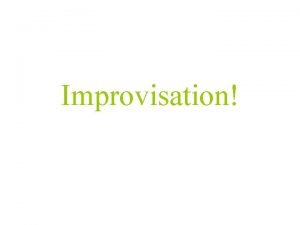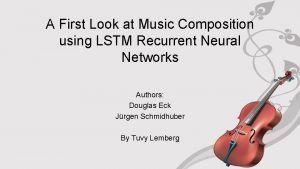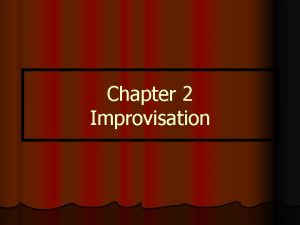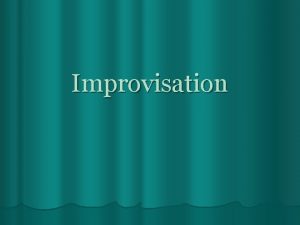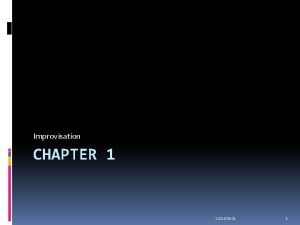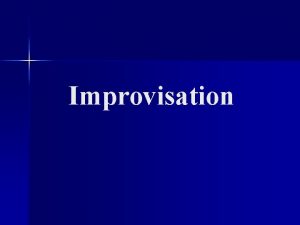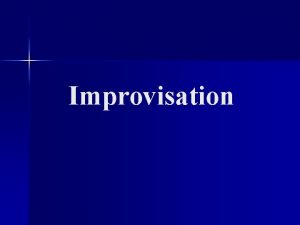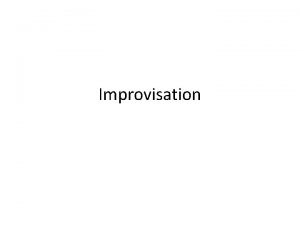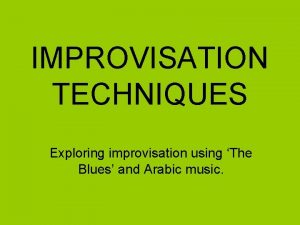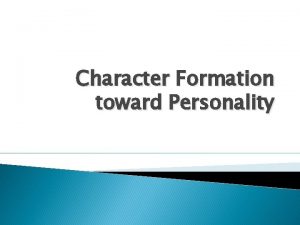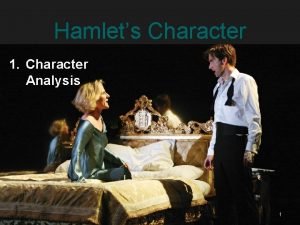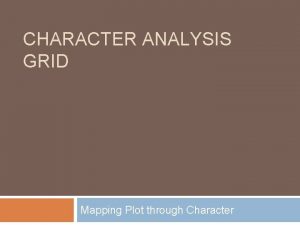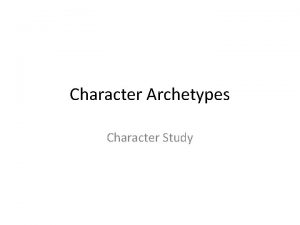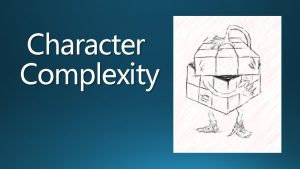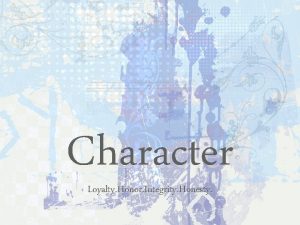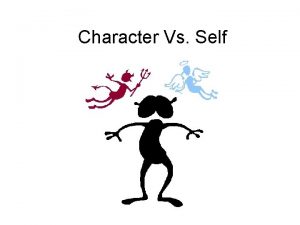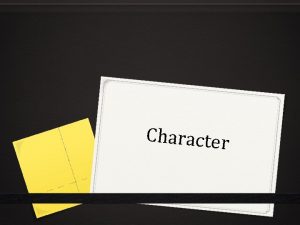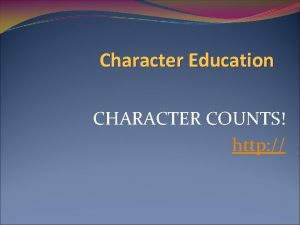Improvisation Unit Improvisation the portrayal of a character



























- Slides: 27

Improvisation Unit

• Improvisation: the portrayal of a character or a scene without rehearsal or preparation. • You must convey personality traits, conflicts, and desires, age and dress with minimal props. • Characterization comes primarily from voice, body language and movement.

• Improvisation focuses your attention on natural actions and reactions and should force you to concentrate on immediate responses.

• Spontaneity: credibility and freshness in each performance. • “Illusion of the first time”: making audiences feel that each performance is the first. • Scene stealing: diverting attention from the other actors.

Character-Centered Approaches • Focus on a character who experiences different situations one after another. • Emphasizes each character’s response to those situations as they occur. (NEMO)

CHARACTER

Situation Centered Approaches • Takes a single situation and places a number of characters in the situation to demonstrate how different personalities will respond to the same event. • Sit-coms (situation comedies)

SITUATION

Get up and Move #1: • 10 volunteers • Students are paired up. Each pair is given a character or a situation centered improvisation starter. • Teams must create an improvisation with the assigned focus; ensuring a strong beginning, middle, and end. • Audience guesses the focus: character centered or situation centered.

Read About Improvisation pg. 8 -12

Reminders for Successful Improvisation • Speak loudly enough to be heard by all audience members • Do not hide behind pieces of furniture or other actors • Move about freely. Don’t stand beside other characters all the time. • Don’t rush with your lines or movement. Create a definite impression. • Stay in Character ALL the time. Listen, speak, and exhibit actions and reactions appropriate for your character.

Improvisation Do’s and Don’ts • Pg. 16 • Find a partner. • Create a sign using pictures, symbols, and/or words which illustrate the Improvisation rule you have been assigned. • Make sure you have the rule number (for example: Do #3) written on your sign as well. You may shorten/abbreviate the wording of the rule itself if needed. • Be ready to present your creative creation in an equally creative way to the class.

Improvisation Rules Poster Rubric: • Your Rule (with number) must be written on the front of your poster. +2 • Names of group members and class period on back. +2 • Use pictures/symbols to help illustrate your rule. +6 • Creativity, neatness, use of space, and quality will be assessed. +5 • Poster presented and rule taught in a creative way. +5


Get up and Move #3: What are you doing? • 2 volunteers will each choose a specific and motivated action to perform. • The first actor begins their action and stays constant in their task. The 2 nd actor will then ask: What are you doing? The 1 st actor (while staying in character and on task) must respond with a new action for the 2 nd actor to begin improvising. • This action goes back and forth until somebody breaks character/action, then a new actor takes their place.

Motivated Sequence • Skilled actors mirror people’s natural responses to internal or external stimulithoughts, actions, or what they hear, see, taste, feel, or smell.

Motivated Sequence 1. You experience the stimulus. 2. You respond instinctively to the stimulus. (primary response) 3. The idea “connects. ” Your brain registers the stimulus -this usually only takes a fraction of a second. (Idea connection) 4. If the stimulus is the kind that causes a reflex action, you might jerk back your head, or you might make a sound. Your eyes look in that direction. Then your body reacts; your chest moves in the direction of the stimulus. (secondary response) 5. You react vocally and/or physically with your (main response).

EXAMPLE: • It is early morning on a school day. You are asleep in bed. The alarm goes off (stimulus). • You awaken (primary response) • Your brain tells you that the alarm is going off (idea connection) • You think-it’s Tuesday-school today. (idea connection) • And you glare at the clock-reflex action (secondary response) • “It’s 6 a. m. ” (idea connection) • You reach out and shut off the alarm (main response)

Create your own Motivated Sequence Map • On your own sheet of paper brainstorm a list of stimulus (See, hear, taste, smell, touch/feel-5 suggestions for each sense) For example: See: rainbow; hear: tardy bell; taste: sour candy; smell: burning waffles; feel: bee sting. Be creative!! • Choose ONE stimulus from your list and create a Motivated sequence “map”. TO BE TURNED IN +15 pts. 1. Identify the steps of Motivated sequence 1 -5 for the suggested stimulus. **Break down the steps of the process of experiencing the stimulus. (detailed description) 2. Make sure to label the Stimulus, Primary response, Idea connection(s) and Secondary Response, Main idea 3. Act it out: You will Include your planned motivated sequence in your designated small group improvisation.

Establishing a Character • Establish a character beforehand • Ask questions and do research to help define your character • Use gestures -movement of any part of your body to help express an idea or an emotion. • Use Facial expressions and Audible Cues: A simple raised eyebrow, silent stare, one word response, or a groan might convey more info about your character than a bunch of dialogue.

• http: //www. youtube. com/watch? v=n. Bm. Ncy 4 z. ZNU&feature=BFa&list=PLBDE 7 C 75872 A 165 D 1 • http: //www. youtube. com/watch? v=p 8 JYm. Vs 1 j 0&list=PLBDE 7 C 75872 A 165 D 1


Walk and Master Gesture Activity • Who is the Grinch? • What kind of person is the Grinch? • How is the Grinch different from the other Characters? • What does the Grinch want? • What are the fewest things you can do to convey the most information about the Grinch?

Character Create Listen to the 6 Music samples. Choose 4 songs that appeal to you. Allow the music to inspire you in creating a specific character by answering the following questions. • • • Who am I? What kind of person am I? How am I different from the other characters? What does my character want? What are the fewest things I can do to convey the most information about my character?

Creating a Character Honey Comb Style! 1. CREATE UR CHARACTER 5. A LITTLE= A LOT! WHO RU? ? 4. WHAT DO U WANT? 2. WHAT PERSONALITY? 3. HOW RU DIFFERENT?

Put it All Together Improv. • Find a partner or group of 3. • With your group, Improv. a scene using the motivated sequence you mapped out AND one of the characters you just established. • Develop your character by focus on the answers to the 5 questions we asked. • Remember to see things through the eye’s of your character. • Scenes must have a complete plot development: beginning, middle and end.

Put it all together Improv. Things to consider…… • 1. Which of your pre-establish characters are you going to use? • 2. Why is your character in the situation you have established? (motivation) Ask yourself Why is my character. . . (insert suggested scene) • 3. What is your relationship with the other character? (how do you interact with them) • 4. What is your goal? (what needs to happen in order for your scene to come to an end? ) P. S. When you have reached your goal find a reason to leave (just don’t be too abrupt)
 What is improvisation
What is improvisation A form of vocal improvisation on nonsense syllables.
A form of vocal improvisation on nonsense syllables. Improvisation tips
Improvisation tips Jazz improvisation with lstm
Jazz improvisation with lstm Elements of improvisation
Elements of improvisation Key period
Key period Unit 6 review questions
Unit 6 review questions Hát kết hợp bộ gõ cơ thể
Hát kết hợp bộ gõ cơ thể Ng-html
Ng-html Bổ thể
Bổ thể Tỉ lệ cơ thể trẻ em
Tỉ lệ cơ thể trẻ em Voi kéo gỗ như thế nào
Voi kéo gỗ như thế nào Tư thế worms-breton
Tư thế worms-breton Alleluia hat len nguoi oi
Alleluia hat len nguoi oi Các môn thể thao bắt đầu bằng tiếng bóng
Các môn thể thao bắt đầu bằng tiếng bóng Thế nào là hệ số cao nhất
Thế nào là hệ số cao nhất Các châu lục và đại dương trên thế giới
Các châu lục và đại dương trên thế giới Công thức tiính động năng
Công thức tiính động năng Trời xanh đây là của chúng ta thể thơ
Trời xanh đây là của chúng ta thể thơ Cách giải mật thư tọa độ
Cách giải mật thư tọa độ Làm thế nào để 102-1=99
Làm thế nào để 102-1=99 Phản ứng thế ankan
Phản ứng thế ankan Các châu lục và đại dương trên thế giới
Các châu lục và đại dương trên thế giới Thơ thất ngôn tứ tuyệt đường luật
Thơ thất ngôn tứ tuyệt đường luật Quá trình desamine hóa có thể tạo ra
Quá trình desamine hóa có thể tạo ra Một số thể thơ truyền thống
Một số thể thơ truyền thống Cái miệng nó xinh thế
Cái miệng nó xinh thế Vẽ hình chiếu vuông góc của vật thể sau
Vẽ hình chiếu vuông góc của vật thể sau
